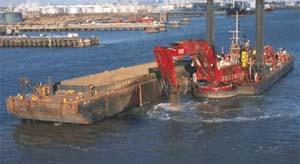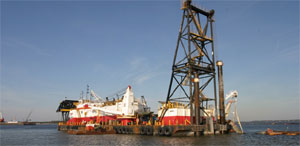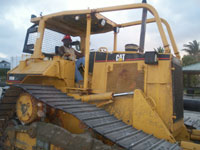Underwater excavation is called dredging. A dredge is a machine that scoops or suctions sediment from the bottom of the waterways or is used to mine materials underwater. While the instrumentation of modern dredges is computer assisted, the basic excavation methods of dredges have remained the same since the late 1800s. The two main types of dredges Local 25 members work aboard are mechanical dredges and hydrhydraulic dredges.
 Mechanical dredges remove material by scooping it from the bottom and then placing it onto a waiting barge or a disposal area. The two most common types of mechanical dredges are dipper dredges and clamshell dredges. These names refer to the type of scooping buckets they employ. The dredge is mounted on a large barge and is usually towed to the dredge site and secured in by anchors or anchor pilings, called spuds. Disposal barges, called dump scows, are used in conjunction with the mechanical dredge.
Mechanical dredges remove material by scooping it from the bottom and then placing it onto a waiting barge or a disposal area. The two most common types of mechanical dredges are dipper dredges and clamshell dredges. These names refer to the type of scooping buckets they employ. The dredge is mounted on a large barge and is usually towed to the dredge site and secured in by anchors or anchor pilings, called spuds. Disposal barges, called dump scows, are used in conjunction with the mechanical dredge.
Hydraulic dredges work by sucking a mixture of dredged material and water from the channel bottom. The amount of water sucked up with the material is controlled to make the best mixture. Pipeline and hopper dredges are the two main types of hydraulic dredges.
 Pipeline dredges suck dredged material through one end and push it out the discharge pipeline directly into the disposal site. Most pipeline dredges have a cutterhead on the suction end. A cutterhead is a mechanical device that has rotating blades or teeth to break up or loosen the bottom material so that it can be sucked through the dredge. Pipeline dredges are mounted to barges and usually not self-powered, but are towed to the dredging site and secured in place by anchor piling, called spuds.
Pipeline dredges suck dredged material through one end and push it out the discharge pipeline directly into the disposal site. Most pipeline dredges have a cutterhead on the suction end. A cutterhead is a mechanical device that has rotating blades or teeth to break up or loosen the bottom material so that it can be sucked through the dredge. Pipeline dredges are mounted to barges and usually not self-powered, but are towed to the dredging site and secured in place by anchor piling, called spuds.
Hopper dredges are ships with large hoppers, or containment areas, inside. The dredge suctions dredged material from the channel bottom through long intake pipes and stores it in the hoppers. When the hoppers are full, the dredged material is either pumped off through a pipeline or the ship travels to an in-water disposal site, where the dredged material is discharged through the bottom of the ship.
 Disposal site selection for dredged material is one of the most important and challenging parts of planning a dredging project. The most common disposal methods are beach renourishment, ocean placement and confined disposal facilities.
Disposal site selection for dredged material is one of the most important and challenging parts of planning a dredging project. The most common disposal methods are beach renourishment, ocean placement and confined disposal facilities.
Beach renourishment is the placement of dredged material on or near the beach through a pipeline, usually to replenish an eroding beach or protect an eroding wetland. This is the most visible dredging project to the public. The dredged material is generally sand coming from inlets, coastal entrance bars, or main offshore waterways. Both hopper dredges and pipeline dredges can use beach renourishment sites. Once the dredged material is on the beach, heavy equipment operators help control the placement and direction of the sand.
With ocean placement disposal sites, a hopper dredge or towed barge sails to a designated area in the ocean, where the dredged material is released. A pipeline can also carry the dredged material from the dredge to the disposal site. In Confined Disposal Facilities, dredged material is placed behind dikes, which contain and isolate it from the surrounding community. As the dredged material settles, the clean water is discharged from the site. There are many uses for the disposal site during and after the dredging process, such as nesting habitats for waterfowl or mining the material for construction fill. Confined Disposal Facilities can also be used to contain and isolate contaminated sediments from the environment.
If you have any inquires, please don't hesitate to contact us.